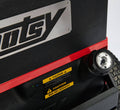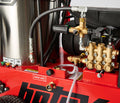The Complete Pressure Washer Maintenance Handbook
Published:
9/1/2021
When it comes to pressure washing, there's nothing more important than reliability and longevity. Having a pressure washer performing at its best will allow you to perform at your best, meet strict deadlines, and keep your operations running without any hiccups. On the other hand, a pressure washer that isn't well taken care of could cause major problems for your business.
This is why we've created the complete pressure washer maintenance handbook. Everything you need to know about keeping your pressure washer up-to-date and running smoothly can be found in this guide.
In this complete pressure washer maintenance handbook, we will discuss all the following:
- Pressure Washer Maintenance Tips for 3 Common Problems
- Hotsy Pressure Washer Training Tips for New Users
- What to Do If Your Pressure Washer Pump Oil Is Milky
- 14-Step Pressure Washer Inspection Checklist
- A Simple Guide to Cleaning Calcium Buildup in Your Pressure Washer
- Signs Your Pressure Washer Needs Repair

Pressure Washer maintenance tips for 3 common problems
Small problems here and there aren't uncommon for pressure washers, especially ones that have been on your job for a while now. The most important thing you can do for these occasions is getting them fixed right away. After all, regular repairs and maintenance are essential to keeping your pressure washer working like its brand new — even years later.
The three most common problems people experience with their pressure washers are:
- Pressure loss
- Pump leaks
- Oil leaks
Losing pressure can come in three forms: no pressure, low pressure, and inconsistent pressure. If you're experiencing this problem, there's a good chance it is because you have an insufficient water source, incorrect nozzle size, blockage in the water flow, or a kink in the hose.
If you're noticing pump leaking, the reason could be damaged pressure seals, or your thermal valve activated. However, it could also be because the water heat exchanger is damaged or there's a crack in the plungers. If this is the case, you will have to either replace the seal or turn your pump off and let it cool before continuing. Finally, if you're experiencing oil leaks, there's a good chance you have a few bolts loose or you need a new seal.
>>Learn more about fixing these 3 common pressure washer problems in this article.
hotsy pressure washer training tips for new users
Proper training is the best way to ensure everyone is using their pressure washer to the best of their ability — and not accidentally causing its early demise.
In fact, if you're new to pressure washers or have some new employees, there's nothing more important than getting trained on pressure washer proper uses. Fortunately, NorTex Sales & Service knows that and created 6 tips for you:
- Create a List of All Pressure Washer Hazards — the best way to prevent safety hazards is to know all of them. This includes dangers to you physically like skin injuries, lacerations, and bone fractures, and electric shock if you're working with an electric-powered pressure washer. There's also always a potential for property damage (stripping off paint, materials, and denting), chemical damage if you have an open wound, and CO2 posing if you're using a gasoline-powered pressure washer in a closed-in space.
- Wear Personal Protective Equipment — to prevent these major hazards from affecting you or your employees, you need to wear protective gear to keep safe. This will allow you to complete your job as safely as possible.
- Understand the Manual — the manual is there for a reason, and it can get particularly dangerous if you just assume you already know everything about a new pressure washer. Either know it inside and out or always have it on hand. Either way, it will keep you informed on troubleshooting, maintenance, repairs, machine operations, and more.
- Exercise Caution — the more cautious you are, the less risk you will face with such a powerful tool. You should always test your pressure washer nozzle before using it, ensure your strength is up for the job, stay updated on the weather forecast, do a run-through on electrical wires and connections before spraying, avoid elevated heights, and ladders, and listen for strange noises.
- Know Your Environment — knowing your environment ensures you're not making mistakes like using a gas-powered pressure washer in a small, enclosed space. Not only can it cause CO2 posing, but the noises are so loud they could damage your hearing.
- Invest Time in Training — finally, it's important to regularly train yourself and your workers on these steps to ensure everyone knows them well and puts them to use. Your safety is so important, and here at NorTex, we've gone above and beyond to ensure you have all the answers to beginner pressure washer questions.
hotsy pressure washer training tips for new users
It can be frustrating after a long day of work — when you're ready to clean up and go home — and you notice there's a problem with your pressure washer. However, getting to that repair right away is the only way to ensure the longevity of your pressure washer and fewer nights where your routine is out of whack. There's a good chance the problem is milky pump oil, and if it is, this is what you'll have to do.
First, it's important to understand what can make your pump oil milky. It could be anything from excess humidity and damaged oil seals to a damaged water heat exchanger and a crack in plungers. Either way, you'll need to disassemble your pressure washer by taking off the casing, removing the fallen socket and valve, repairing the oil ring, re-attaching the pressure washer, and adding oil.
Then, you'll need to replace worn-out packings by purchasing the right packings kit before using an Allen wrench to remove bolts at the back of the pump and the brass rings above the packings. Identify which ones are damaged and replace them with a new set.
14-step pressure washer inspection checklist
Beginning your job with a pressure washer inspection checklist will ensure that your day and performance go smoothly. It will also ensure the job can be done safely. For this reason, we've developed a 6-step inspection checklist for pressure washer maintenance where you check all of the following before getting to work:
- Water, Fuel, and Oil Levels — check oil levels with a dipstick, looking for milkiness or dark discoloration. Examine your water reservoir to ensure it is clean and has adequate water levels. Finally, fill up your fuel reservoir.
- High-Pressure Hose and Nozzle — check for cuts, breakages, or weak lines.
- Drive Belt — turn off your machine to look for wear and tear on the drive belt.
- Scale Deposits — disassemble the coil system in your pressure washer and descale using white vinegar or any available descaling product.
- Power Cord — look for defections like cuts and exposed wire on your power cord to prevent electrocutions.
- Surrounding Area — you should never use your pressure washer on untested grounds.
- Fluid Leaks — check your inlet, pump, piston seal, and thermal release valve for any leaks or cracks.
- Condition of System Pressure — make sure it comes within 5-10% of the normal pressure gauge.
- Chemical/ Detergent Delivery — look for defects in the valve or the downstream injection system to ensure there are no problems with delivery.
- Trigger Gun — examine your trigger gun for signs of damage to your inlet, outlet, nozzle, or valve.
- Burner Operation — check and drain your burner fuel liner every day.
- Heat Exchanger for Sooting — disassemble the coils in your heat exchanger and remove the soot to avoid overheating during an operation.
- Chemical Inventory — rinse your detergent/chemical compartment under running water for two minutes when you're done.
- Verify Cool Down Phase — make sure your pressure washer has the chance to cool down before it goes into storage or going onto the next job (typically 10 to 20 minutes).
a simple guide to cleaning calcium buildup in your pressure washer
Since more than half of the U.S. has hard water, there's a good chance you will deal with calcium buildup in your pressure washer at least once — if not, more often. For this reason, we've gathered everything from the negative effects of not addressing the calcium buildup right sway to some maintenance tips you can use to get rid of the problem before it gets worse.
Common results of calcium buildup include a restriction of water flow and reduced effectiveness of soap and detergents. To prevent this from happening, you should allow the washer's heat coil to cool down completely after every session and use water softeners whenever possible. From there, cleaning up your calcium buildup is very important. Here's how to do it properly:
- Remove all the parts and accessories to clean them.
- Clear the pressure washer of water and run vinegar through it.
- Have your pressure washer regularly maintained by a professional to keep it safe from calcium buildup in the long term.
signs you need pressure washer repair
Repairs and replacements are inevitable with any powerful tool, and your pressure washer is no exception. The more aware you are of the common uses that suggest you need a repair, the better prepared you will be in addressing the problem at an appropriate time.
For this reason, here are a few common issues that occur that may mean you need a repair:
- Leaking — leaking is one of the most common repair issues you can run into. If you notice that your pressure washer is leaking, this could mean that you need to repair the seal because it's worn out. Since there are several seals that keep liquids contained, it's important that you find and fix the problem immediately before it becomes particularly dangerous (for instance, if oil is leaking).
- Low Pressure — low pressure can result from several factors: your pressure gauge is damaged, your nozzle needs to be changed (size determines the level of pressure), or leaks may be causing the loss in pressure.
- Pressure Washer Won't Start — if you're using an electric pressure washer, there's a good chance that you are running too many things at once. On the other hand, if you're using a gas one, the problem could be that you need more gas or oil to keep the job going.
- Starting Then Stopping — if you notice that your pressure washer keeps starting and stopping, check to see if your fuel cap vent is clogged (air may be getting trapped) or the carburetor is clogged (happens when the furl was left in the washer for too long).
- Choppy Operating/Making Loud Noises — this problem can be caused by not having enough oil in the engine or oil in the pump if you have a blocked water intake. If those are not the cause, a service professional can help you identify the problem more closely.
Find the Best Deals With NorTex Sales & Service
Now that you know how to properly take care of your pressure washers to maintain their performance, reliability, and longevity — it's time to get you connected with the right pressure washers for your job.
There can be a lot that goes into getting the right fit for your job purpose, so don't hesitate to meet with our team at NorTex Sales & Service to ensure it's the perfect fit. In the meantime, contact us for more information about pressure washer maintenance.
Share this Article ↓




